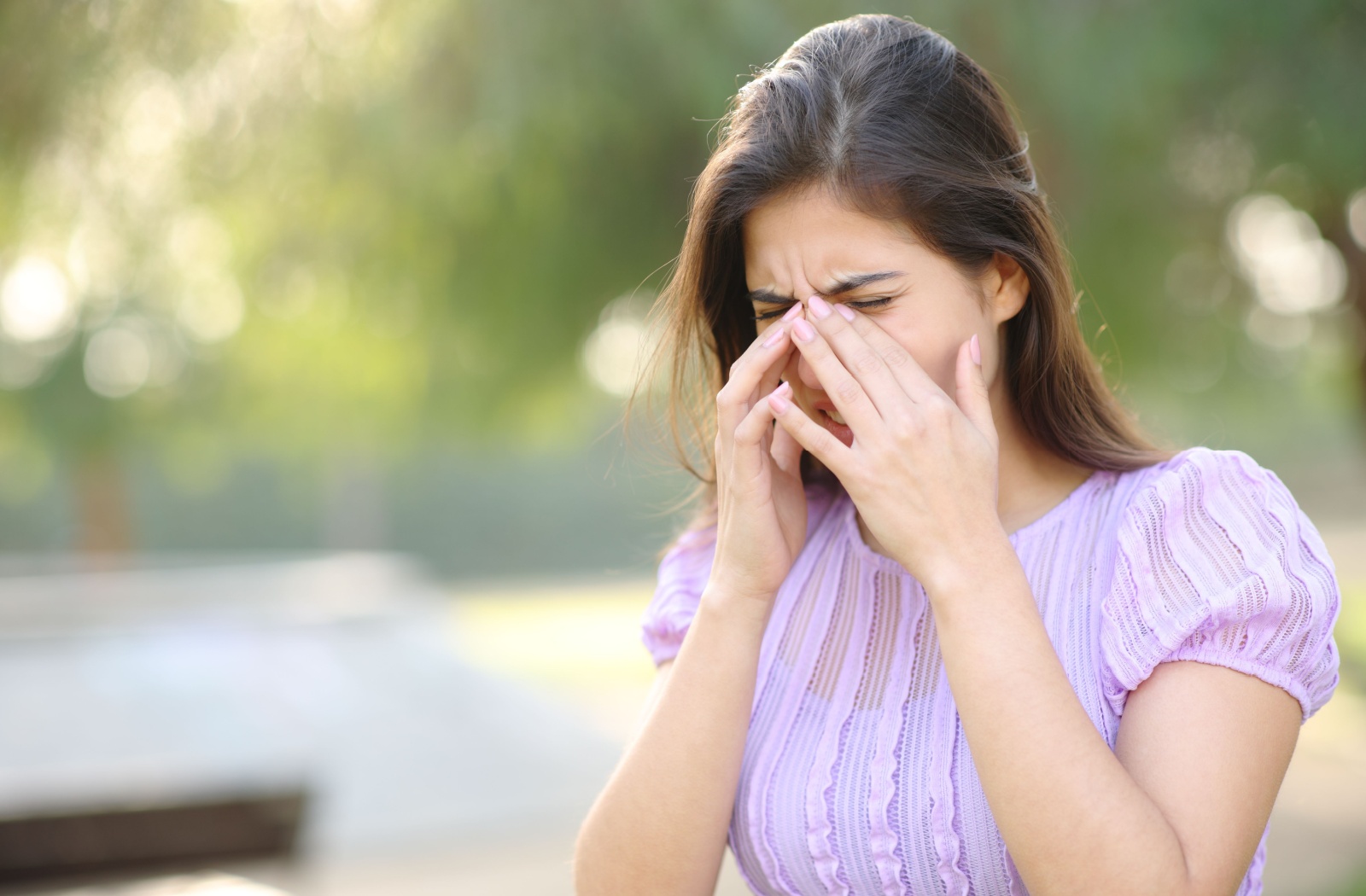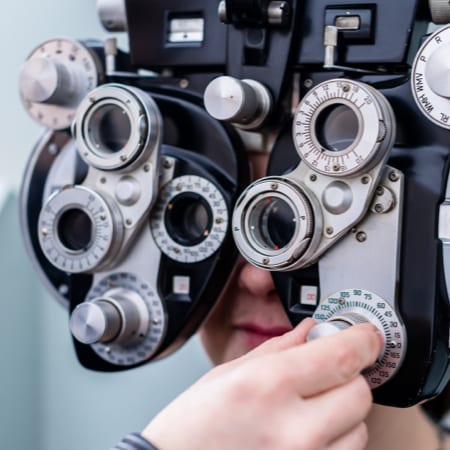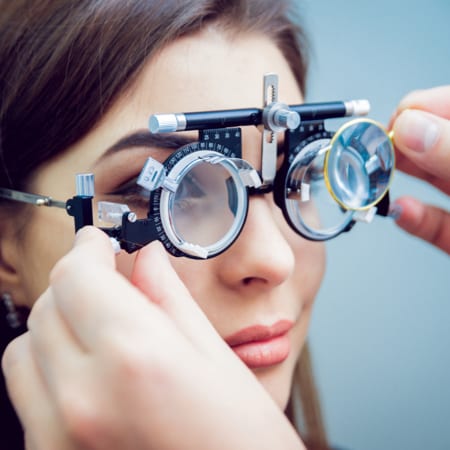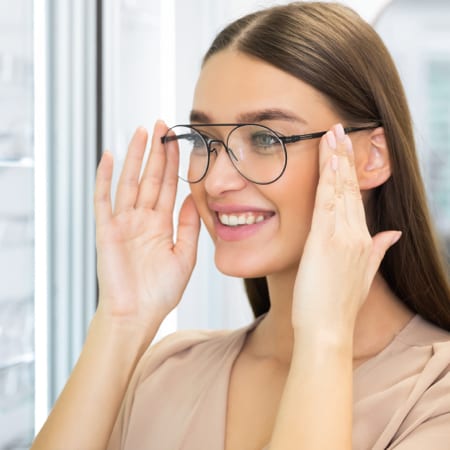Red, itchy eyes are a common complaint, often leading to considerable confusion. Is it pink eye? Are allergies flaring up? If you’re struggling to identify what’s causing your discomfort, the differences (and similarities) between pink eye (conjunctivitis) and eye allergies might surprise you.
Here’s the simplest way to differentiate: Pink eye is typically caused by an infection and often produces a thicker discharge, while allergies mainly involve itchiness and watery eyes.
The eyes may be small, but diagnosing their discomfort can require a bigger picture. Whether it’s infectious or seasonal, optometrists can help you get clarity.
What Is Pink Eye?
Pink eye, also known as conjunctivitis, is inflammation of the conjunctiva, the thin layer covering your eye and the inside of your eyelids. Its infectious forms can be either bacterial or viral, which have their own slight differences to watch out for:
- Bacterial conjunctivitis is caused by bacteria coming into contact with your eye, often through contaminated hands or surfaces. This type is typically characterized by thick, yellow, or green discharge and can be highly contagious, quickly spreading through schools and workplaces.
- Viral conjunctivitis often accompanies a cold or respiratory infection and is spread through coughing, sneezing, and contact with contaminated surfaces. Its discharge is watery and less viscous than the bacterial kind.
Although many people discuss pink eye and eye allergies as two distinct conditions, allergies are a form of conjunctivitis—allergic conjunctivitis. Unlike bacterial and viral conjunctivitis, it’s not contagious. In that way, it’s more similar to chemical conjunctivitis, which is caused by exposure to irritants such as smoke, chemicals, or chlorine.
This doesn’t stop people from often mistaking eye allergies for other types of conjunctivitis due to similar symptoms.
What You Should Know About Eye Allergies
Eye allergies, or allergic conjunctivitis, stem from the body’s overreaction to environmental substances such as pollen or pet dander. When exposed to allergens, your immune system releases histamines, causing redness, itching, swelling, and watery eyes. Not everyone has the same triggers, which can make allergies appear random.
Allergens can exist anywhere, whether you’re staying inside or exploring the outdoors. Seasonal allergies typically appear in the spring and fall, triggered by pollen from trees and grass. Meanwhile, indoor allergens like dust mites or pet dander can cause symptoms year-round.
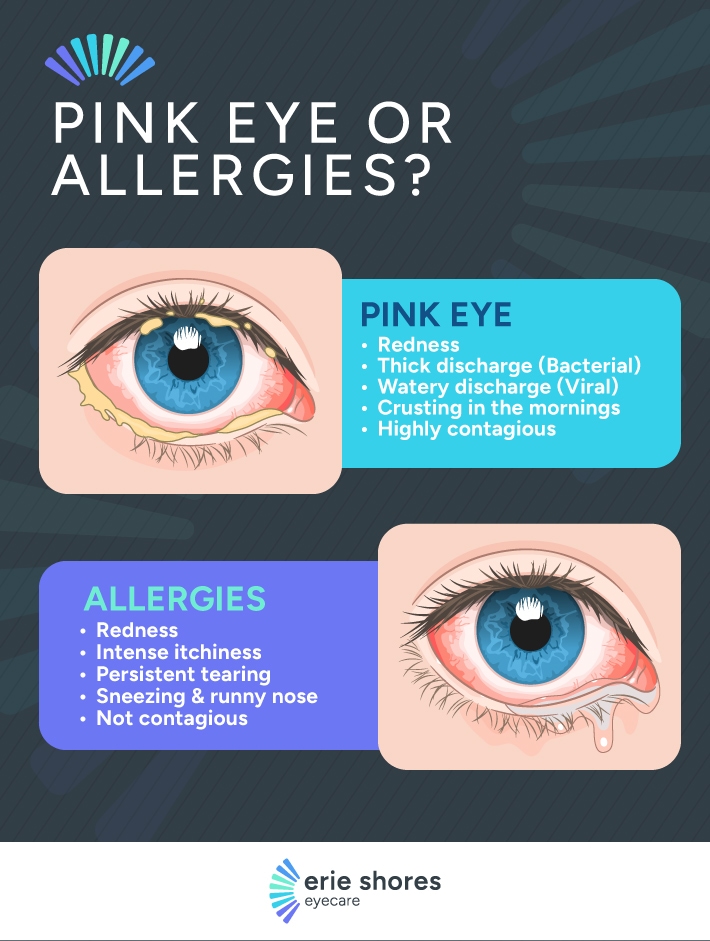
Key Differences Between Pink Eye & Eye Allergies
Though pink eye and allergies share overlapping symptoms, some stark differences can help you identify the cause of your eye irritation.
Comparing Symptoms
When dealing with pink eye, you’ll often notice symptoms like:
- Redness and swelling, but it may only affect one eye
- Discharge that can range from watery to thick with pus (yellow/green)
- Eyes crusted shut, particularly upon waking
- Pain or a gritty sensation
- Viral pink eye may occur alongside a cold
While similar, eye allergies can cause:
- Redness and puffiness in both eyes
- Watery discharge, no pus
- Severe, constant itching
- Swollen eyelids
- Other allergy symptoms, such as a runny nose and sneezing
Onset & Duration
Pink eye can develop quickly, usually infecting one eye before spreading to the other. The symptoms of bacterial or viral conjunctivitis typically last 1 to 2 weeks.
Eye allergy symptoms, on the other hand, may relieve themselves shortly after you leave the environment containing the allergen, but can persist as long as the allergen remains present.
Contagious vs Non-Contagious
A critical difference is that pink eye can be highly contagious in its bacterial and viral forms, whereas eye allergies are never contagious. That means if your entire family is waking up with redness, there’s a chance it could be pink eye spreading.
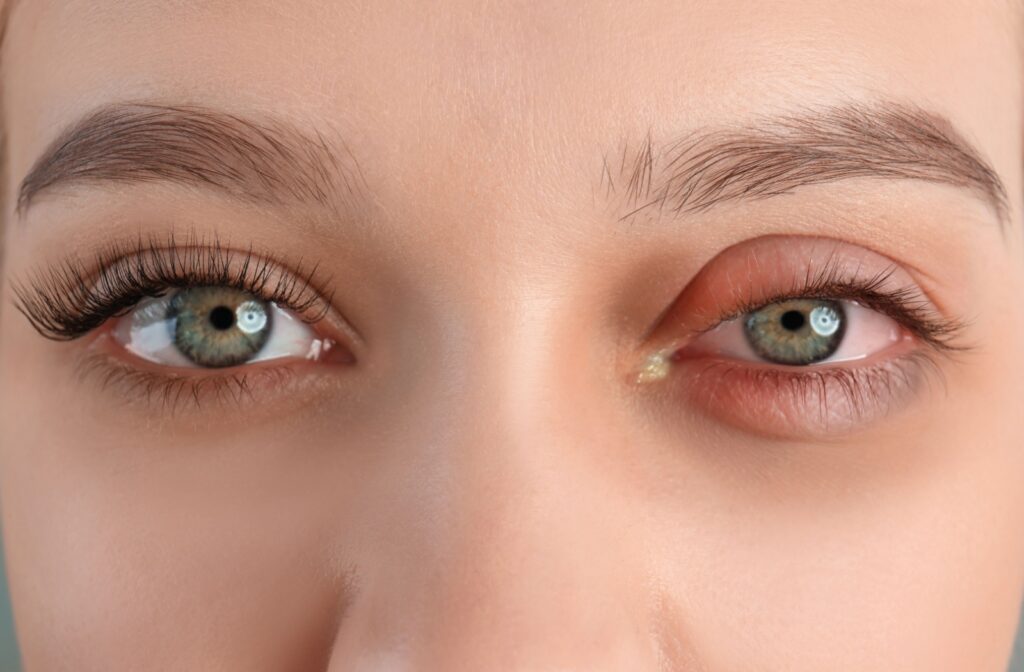
Treating Pink Eye & Allergies
Once you identify the cause of your symptoms, the next step is to receive effective treatment. The best option ultimately comes down to addressing what’s affecting you, with the goal of achieving relief.
Treating Pink Eye
Infectious pink eye usually goes away on its own. Viral conjunctivitis typically resolves within 1–2 weeks, while bacterial conjunctivitis can persist for 7–10 days.
If your bacterial pink eye doesn’t get better, your eye doctor can treat it with prescription antibiotic eye drops or ointments. This helps speed up recovery and prevents the spread of infection.
In the meantime, you can manage discomfort with cold compresses, artificial tears, and rest.
Treating Allergies
Often, the best way to deal with allergies is to avoid the triggering allergen. In cases where this isn’t possible or you don’t know what the trigger is, antihistamines, like over-the-counter allergy medications, help manage your body’s misdirected immune response.
Rinsing your eyes with artificial tears can help flush out allergens and provide quick relief.
Home Remedies for Both
For all their differences, some remedies are universal. If you’re dealing with irritation, here are some tips:
- Apply a clean, cold compress to reduce redness and swelling.
- Avoid rubbing your eyes, as it can aggravate symptoms or spread infection.
- Maintain hygiene by washing your hands frequently and replacing items such as pillowcases and makeup products.
Preventing Pink Eye & Allergies
Preventing further irritation or avoiding the spread of pink eye can save you and those around you a lot of hassle.
Preventing Pink Eye
- Wash your hands regularly.
- Avoid touching or rubbing your eyes.
- Don’t share towels, bedding, or makeup.
- Follow contact lens hygiene advice from your optometrist.
Preventing Eye Allergies
- Limit exposure to allergens by cleaning your home, using air purifiers, or staying indoors on high-pollen days.
- Wear wraparound sunglasses to protect your eyes from allergens outdoors.
- Keep windows closed during pollen season and use a HEPA filter in your air conditioning.
When to See Your Optometrist
Sometimes, symptoms can become overwhelming and require professional intervention. If you’re not sure if it’s time to visit your optometrist for pink eye or eye allergies, here are some signs to look out for:
- Persistent redness, itchiness, or swelling that doesn’t improve with over-the-counter allergy or eye drops.
- Discharge or crusting around the eyes, especially if it’s yellow or green.
- Sensitivity to light or blurred vision that persists.
- Symptoms that worsen or don’t improve after a few days.
Regular checkups and timely care can prevent complications. If you’re dealing with any of these issues, it’s a good idea to book an appointment—your eyes will thank you!
Protect Your Family’s Vision From Whatever Comes
Clearer, healthier eyes are just a step away! Whether you’re dealing with pink eye or allergies, Erie Shores Eyecare’s experienced optometrists are here to answer your questions and offer effective solutions.
Book your appointment today and discover how we can help keep your eyes comfortable, healthy, and happy. There’s no question about it; your eyes deserve the best care.


